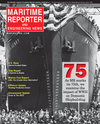
Page 26: of Maritime Reporter Magazine (January 2014)
Ship Repair & Conversion Edition
Read this page in Pdf, Flash or Html5 edition of January 2014 Maritime Reporter Magazine
26 Maritime Reporter & Engineering News • JANUARY 2014
SHIP REPAIR & CONVERSION
I n the U.S. and across the globe, shipyards create solid, long-term economic stability in their re- gions. Ship construction and re- pair requires an extraordinary amount of expertise, time and resources.
This work is made even more challeng- ing because current economic pressures drive companies to reduce costs wherev- er possible without hindering production or quality. Having multiple shipyards in a region creates a naturally interdepen- dent, yet highly competitive culture.
This is because the industry shares a geo- graphically close environment and has to rely on shared resources to protect com- mon interests even while competing for projects. Shipyards have the potential to create innovative cultures because their master craftsmen have perfected tech- niques, effi ciencies and quality controls that can be passed down to apprentice levels. This frees up the craftsmen’s time to further improve upon existing prac- tices. Competition could impede syner- gies that would potentially strengthen the industry as a whole. Even though companies seek competitive advantag- es, they must maintain a focus on com- monalities to ensure collaboration on overall industry expertise and capacity improvements. In Virginia, we have nine shipyards, 250+ companies and more than 40,000 workers working in the in- dustry. The synergies that emerge from interdependent environments can breed effi ciency and innovation. Companies in
Virginia realize that working together on specifi c cost-saving projects can benefi t the entire industry without diminishing their individual business advantages.
These companies have several exam- ples of collaborative projects that have resulted in identifying key elements that make joint efforts more likely to succeed.
For example, ship work is extremely challenging from a safety perspective, and requires a high level of diligence and preventative measures. In Virginia, ship- yards have implemented a common Safe- ty Orientation. This provides all workers access to consistent resources that estab- lish baseline expectations. This reduces costs by eliminating duplicate training, while helping to prevent misunderstand- ings when projects are performed by multiple companies on the same ship.
The ability for an individual shipyard to singularly control their working envi- ronments is also complicated by having such a highly fl uid workforce. Shipyard workers who have acquired a great deal of expertise over time may work at mul- tiple facilities to accomplish complex jobs. This may cause challenges in the area of quality assurance. To address this issue, the companies collectively created a quality assurance audit program. The program allows all companies to utilize a common system of standards which eliminates the need for multiple audits and allows the yards to collectively monitor where improvements might be made. This audit program provides cost savings for everyone. The success of these two examples involved consistent commitment from dozens of companies.
The following list outlines key ele- ments identifi ed by these companies that make such joint efforts more likely to succeed. 1. Find the point of synergy. This is the target identifi ed that affects all companies equally without infringing on competitive advantage. Safety and quality mentioned above are examples of common core issues that impact every company in our industry. 2. Leadership. Everyone is invited to the table, but the largest and most rel- evant companies must believe that ad- dressing a particular point of synergy has benefi ts for everyone and is worth an investment of their time and resources. 3. Neutral Facilitation. The adminis- tration and execution regarding the point of synergy should be facilitated by a neutral party. It is important that no one competitor thinks another one is driving the train to their own advantage. Even though some companies may benefi t more than others, or the effort may be more strongly supported by some com-
By William W. “Bill” Crow & Michelle L. Tomaszewski, VSRA
Shipyards gain Strength through Synergies
MR #1 (26-31).indd 26 1/7/2014 10:37:11 AM

 25
25

 27
27
